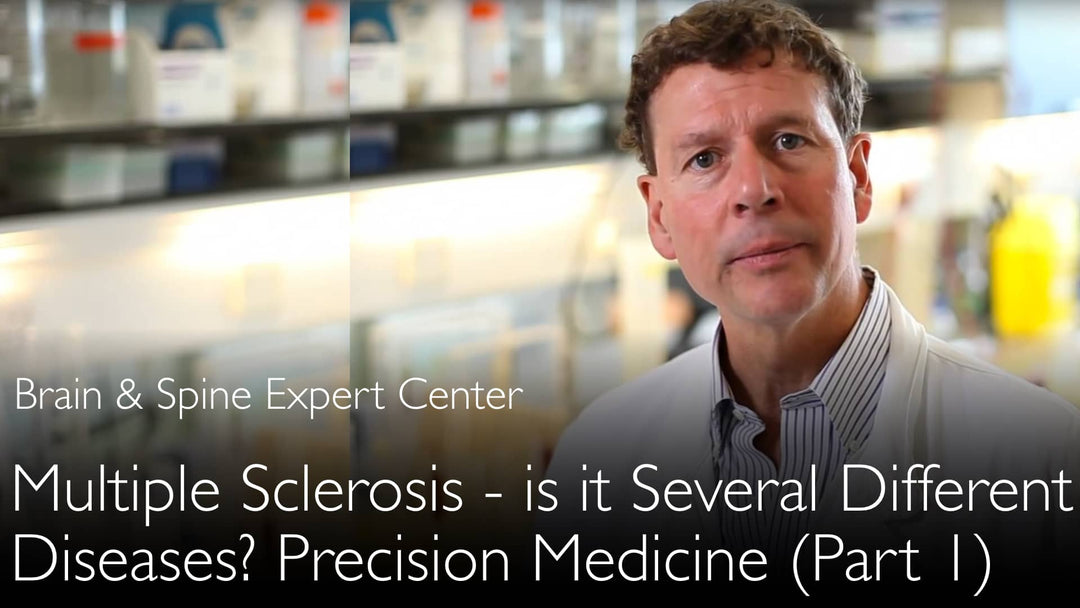Leading expert in multiple sclerosis and neuromyelitis optica, Dr. Paul Matthews, MD, explains the heterogeneity of multiple sclerosis as a clinical syndrome. He details how patients experience vastly different disease courses, from benign to rapidly progressive. Dr. Paul Matthews, MD, highlights neuromyelitis optica (NMO) as a distinct pathophysiological entity within the MS spectrum, characterized by severe optic neuritis and spinal cord lesions. He discusses the role of advanced MRI imaging and biomarkers in personalizing treatment strategies for these complex neuroinflammatory conditions.
Understanding Multiple Sclerosis Heterogeneity and Neuromyelitis Optica
Jump To Section
- Multiple Sclerosis as a Clinical Syndrome
- Wide Spectrum of Clinical Presentations
- Two Theories Explaining MS Heterogeneity
- Neuromyelitis Optica as a Distinct Entity
- MRI Imaging Characteristics in NMO
- Implications for Personalized Treatment
- Full Transcript
Multiple Sclerosis as a Clinical Syndrome
Dr. Paul Matthews, MD, clarifies that multiple sclerosis is diagnosed as a syndrome, not by a single specific biomarker. He explains to Dr. Anton Titov, MD, that the diagnosis relies on a collection of specific clinical presentation symptoms. These symptoms are typically supported by laboratory evidence pointing to inflammatory disease affecting both the white and gray matter of the central nervous system.
The diagnosis often depends on identifying MRI abnormalities in particular anatomical distributions while also ruling out other potential causes for the neurological symptoms. This syndromic approach to diagnosis is a fundamental reason for the observed variability in how the disease manifests and progresses in different individuals.
Wide Spectrum of Clinical Presentations
The heterogeneity within multiple sclerosis is profound, as detailed by Dr. Paul Matthews, MD. He describes a wide spectrum of clinical courses to Dr. Anton Titov, MD. A small proportion of patients experience a very good prognosis with little progression of disability over 20 or more years.
In stark contrast, other patients show rapid progression of disability from the outset. The frequency of relapses also varies significantly; some patients have infrequent attacks while others suffer from frequent relapses. This variability extends to the timing of disability progression, which can begin immediately or only manifest in the late stages of the disease.
Two Theories Explaining MS Heterogeneity
Dr. Paul Matthews, MD, outlines two primary hypotheses for this clinical heterogeneity in his discussion with Dr. Anton Titov, MD. The first and most common explanation is that MS is a multifactorial disease. It arises from a combination of multiple genetic susceptibility factors interacting with various environmental and lifestyle influences, which differ from patient to patient.
The second hypothesis proposes that within the multiple sclerosis syndrome, there are recognizably distinct pathophysiological processes. These different processes can present with similar clinical symptoms but may be defined by distinct underlying mechanisms. This theory suggests that what is called "MS" may actually be several different diseases with a common final clinical pathway.
Neuromyelitis Optica as a Distinct Entity
Dr. Paul Matthews, MD, identifies neuromyelitis optica (NMO) as the clearest example of a distinct entity within the MS spectrum. He explains to Dr. Anton Titov, MD, that NMO was clinically recognized as a relatively unusual syndrome characterized by the conjunction of optic neuritis and typically severe spinal cord presentations.
Patients with NMO often experience a more malignant disease course where each relapse is associated with significant irreversible functional impairment. Dr. Matthews also notes important epidemiological differences, with NMO found more commonly in Asian populations compared to Caucasian groups, suggesting distinct genetic or environmental factors at play.
MRI Imaging Characteristics in NMO
Advanced MRI imaging provides critical diagnostic clues for differentiating NMO from typical multiple sclerosis. Dr. Paul Matthews, MD, describes to Dr. Anton Titov, MD, the most prominent MRI sign of neuromyelitis optica: longitudinally extensive T2 hyperintense inflammatory lesions in the spinal cord.
These lesions typically extend over three or more vertebral segments, distinguishing them from the shorter lesions more commonly seen in MS. Additionally, NMO patients show a relatively sparser frequency of cerebral lesions on brain MRI compared to patients with classical multiple sclerosis, providing radiologists with important differential diagnostic criteria.
Implications for Personalized Treatment
The recognition of distinct entities like neuromyelitis optica within the multiple sclerosis spectrum has profound implications for treatment personalization. Dr. Paul Matthews, MD, emphasizes to Dr. Anton Titov, MD, that understanding these pathophysiological differences is crucial for selecting appropriate therapy.
Treatment strategies that work for typical MS may be ineffective or even harmful for NMO patients, highlighting the necessity of accurate diagnosis. This approach to personalized medicine in neuroinflammatory disorders ensures that patients receive targeted therapies based on their specific disease biology rather than a one-size-fits-all treatment strategy.
Full Transcript
Dr. Anton Titov, MD: Multiple sclerosis types, neuromyelitis optica (NMO), syndrome presentations. Precision medicine advances often lead to an interesting discovery. A disease was considered to be a single entity, but it may consist of several distinct molecular entities. Even though there is a common final pathway of clinical manifestations for that disease, it can make this disease entity look the same.
This is especially true for many cancers. There is a similar view about multiple sclerosis. Multiple sclerosis might also represent several distinct pathophysiological entities. Perhaps that can explain a very wide heterogeneity in the clinical course of multiple sclerosis. It may also explain the challenges in treatment strategy selection for patients with multiple sclerosis.
Dr. Anton Titov, MD: Is there any evidence for multiple sclerosis' heterogeneity? What do advanced MRI imaging clinical trials show? You conduct many clinical trials in your multiple sclerosis research.
Dr. Anton Titov, MD: How to personalize therapy selection for multiple sclerosis patients?
Dr. Paul Matthews, MD: Multiple sclerosis is diagnosed as a syndrome. It is a collection of a particular type of clinical presentation symptoms. Typically, these days, symptoms are supported by laboratory evidence for inflammatory disease in the white and gray matter.
In some cases, multiple sclerosis appears in particular anatomical distributions. MRI abnormalities may also exist in the absence of evidence for other potential causes. We don't diagnose multiple sclerosis by a specific type of biomarker.
Within the syndrome of multiple sclerosis, we also observe a range of clinical presentations. Some patients with multiple sclerosis have a very good prognosis. These are some very lucky patients. It is a small proportion. They may be followed for 20 more years and show little progression of disability.
Other patients may show rapid progression of disability of multiple sclerosis. Some patients may have infrequent relapses. Others may show frequent relapses. Some patients may start with progressive multiple sclerosis. It is a disability progression from the start.
Others may start disability progression only in the late stages of multiple sclerosis. This heterogeneity of the multiple sclerosis syndrome can be explained in two different ways. One point is that it is a multifactorial disease. It arises from multiple genetic susceptibility factors.
Dr. Anton Titov, MD: There are influences of the environment and lifestyle on multiple sclerosis. They may vary from patient to patient. This is commonly seen with a variety of other diseases. In fact, this is among the most common of explanations.
Interplay between genetic susceptibility and environmental factors explains different clinical symptoms in diseases with syndrome presentations. The other hypothesis is this: within multiple sclerosis syndrome, there are recognizably distinct pathophysiological processes. They may look like multiple sclerosis, but they can be defined in distinct ways.
The most prominent example of this is neuromyelitis optica (NMO). This is really one of the only terribly clear examples of multiple sclerosis variability to date. Clinically, neuromyelitis optica was recognized to be a syndrome that was relatively unusual within the multiple sclerosis spectrum.
Dr. Anton Titov, MD: Optic neuritis and typically relatively severe spinal cord myelopathic presentations were conjoined in a group of patients. Moreover, these patients often showed a relatively malignant course. Each relapse was associated with significant irreversible functional impairment.
There were also ethnic differences in the frequency of this aspect of the neuromyelitis optica syndrome. It was found more commonly in oriental populations than in the Caucasian group. From an MRI imaging standpoint, NMO patients showed some very particular signs.
The most prominent sign of neuromyelitis optica on MRI was longitudinally extensive T2 hyperintense inflammatory lesions in the spinal cord. There was a relatively sparser cerebral lesions frequency in neuromyelitis optica.




